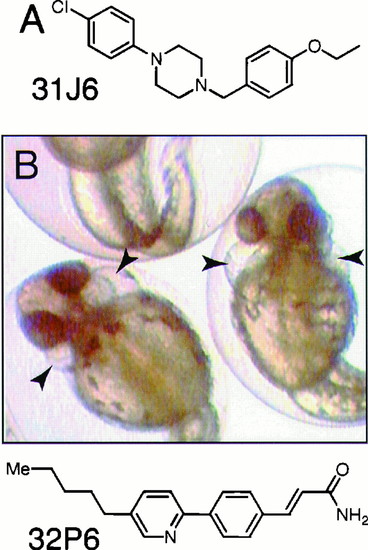- Title
-
Small molecule developmental screens reveal the logic and timing of vertebrate development
- Authors
- Peterson, R.T., Link, B.A., Dowling, J.E., and Schreiber, S.L.
- Source
- Full text @ Proc. Natl. Acad. Sci. USA
|
Small molecules alter development of the central nervous system. (A) Untreated zebrafish embryo. (B) Embryo treated with the small molecule 32N8 at a concentration of 2 μg/ml. The enlarged hindbrain ventricle is indicated by an arrowhead. (C) Embryo treated with the small molecule 33M20 (2 μg/ml). The folds in the notochord are indicated by arrowheads. (D) Embryo treated with the small molecule 32N5 (2 μg/ml). Hindbrain projections are indicated by arrowheads. All embryos were photographed 25 hpf. |
|
Small molecules alter development of the heart. (A) The structure of the small molecule 31J6. (B) Ventral view of embryos treated with the small molecule 32P6 (2 μg/ml). The two putative pericardial sacs are indicated by arrowheads. Embryos were photographed 76 hpf. |
|
Small molecules affect specific stages of pigment cell development. Zebrafish embryos were treated with 2 μg/ml of the small molecules 31B4 (A) or 33N14 (B) during the 3 dpf, after which the embryos were transferred to fresh water and allowed to grow for an additional 2 days in the absence of the small molecules (31B4 and 33N14 in C and D, respectively). The PRE is indicated by arrowheads. |
|
The small molecule 31N3 alters ear development between 14 and 26 hpf. (A) Untreated zebrafish embryo photographed 36 hpf. The two otoliths are indicated with arrowheads. (B) Embryo treated with 31N3 from 2 to 36 hpf and then photographed. The expected locations of the two otoliths are indicated by arrowheads. (C) Embryos were treated with 31N3 at a concentration of 2 μg/ml during the times indicated by black bars, after which the embryos were transferred to fresh fish water. The presence of otoliths was scored at 54 hpf. (D) The structure of the small molecule 31N3. The olefin is trans as confirmed by nuclear magnetic resonance, coupling constant 15.6 Hz. (E) Embryo treated with 31N3 from 14 to 26 hpf and then allowed to develop in the absence of 31N3 until 36 hpf. The embryo was photographed 36 hpf. The single otolith is indicated by an arrowhead. |




